India hails polio-free 'milestone'
- Published
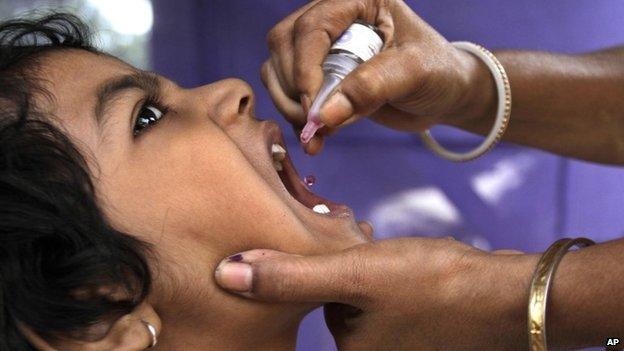
More than 2.4 million volunteers vaccinate some 170 million children in India during every immunisation round
India is marking three years since its last reported polio case, a landmark in the global battle against the disease.
It is seen as confirmation of one of India's biggest public health successes, achieved through a massive and sustained immunisation programme.
India's health minister hailed it as a "monumental milestone".
In 2012 the World Health Organisation (WHO) removed India from the list of polio-endemic countries. Pakistan, Afghanistan and Nigeria remain on it.
The list refers to countries in which the virus is circulating freely and the transmission of the infectious disease has not been stopped.
Despite India's success, health experts fear a resurgence of polio in other parts of the world.
Last case
"This monumental milestone was possible due to unwavering political will at the highest level, commitment of adequate financial resources, technological innovation ... and the tireless efforts of millions of workers including more than 23 lakh (2.3 million) vaccinators," Health Minister Ghulam Nabi Azad told reporters.
The WHO is expected to formally certify India's polio-free status next month after testing its last samples.
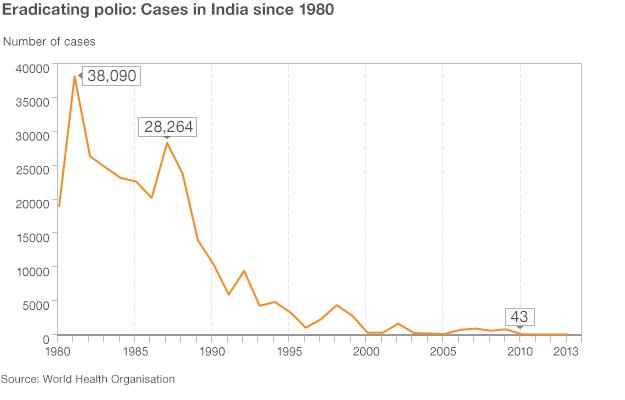
"India has now set other important public health goals as a result of the confidence that the country has got from the successful eradication of polio," the WHO's Hamid Jafari told AFP news agency, citing a new goal to eradicate measles.
Only one case of polio was recorded in India in 2011, down from 741 in 2009. It came from the eastern state of West Bengal in 2011 when an 18-month-old girl was found to have contracted the disease.
Rukshar Khatoon is now going to school and leads a "normal life" although she still suffers pain in her right leg, her doctors and parents told AFP.
"She can now stand on her feet and walk, but can't run. When her friends play, she remains a spectator," her father Abdul Shah said.
Mr Shah said it had been a "grave mistake" only to get his son vaccinated for polio, but not his two daughters.
After the eradication of smallpox in 1980, polio is the second disease in India that has been eliminated through immunisation.
Nearly 2.3 million volunteers vaccinate some 170 million children under five years of age in India during every round of immunisation.
Polio is capable of causing crippling disability or death within hours. It plagued societies in ancient times - and was present in more than 100 countries even in the 1980s, when it left 350,000 people paralysed each year.
Global cases have decreased since then as part of a mass eradication programme - to 372 last year.
Despite the quarter-century-long vaccination programme, experts fear it could make a comeback in countries riven by fighting.
Most of last year's cases were in conflict areas like Somalia and Syria, where polio had previously been eradicated.
Polio immunisation efforts have also been suspended in parts of Pakistan, where it has never been eliminated, because of attacks by militants who see the campaign as a Western plot.
BBC correspondents say unless immunisation is re-started promptly, polio could infect more children, with a risk it could spread beyond Pakistan's borders to India.
But Hamid Jafari at the WHO stressed polio cases were still falling in endemic countries.
"If the current trends of progress continue we could very easily see the end of polio in Afghanistan and Nigeria in 2014."
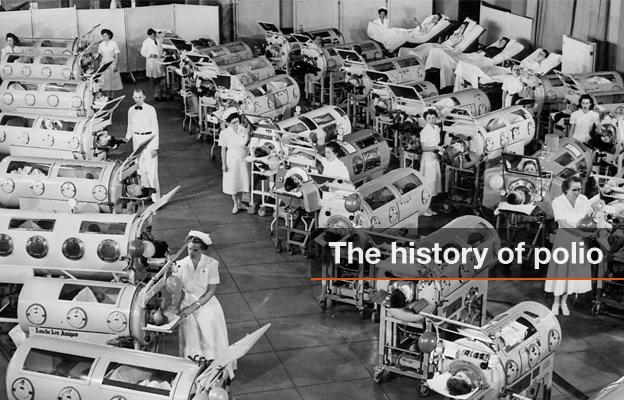
Poliomyelitis has existed as long as human society, but became a major public health issue in late Victorian times with major epidemics in Europe and the United States. The disease, which causes spinal and respiratory paralysis, can kill and remains incurable but vaccines have assisted in its almost total eradication today.
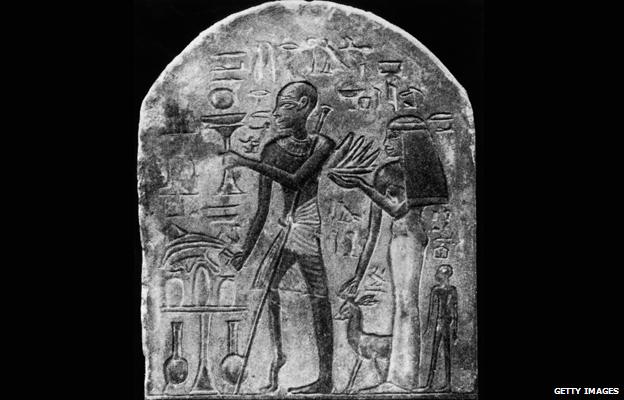
This Egyptian stele (an upright stone carving) dating from 1403-1365 BC shows a priest with a walking stick and foot deformities characteristic of polio. The disease was given its first clinical description in 1789 by the British physician Michael Underwood, and recognised as a condition by Jakob Heine in 1840. The first modern epidemics were fuelled by the growth of cities after the industrial revolution.

In 1916, New York experienced the first large epidemic, with more than 9,000 cases and 2,343 deaths. The 1916 toll nationwide was 27,000 cases and 6,000 deaths. Children were particularly affected; the image shows child patients suffering from eye paralysis. Major outbreaks became more frequent during the century: in 1952, the US saw a record 57,628 cases.
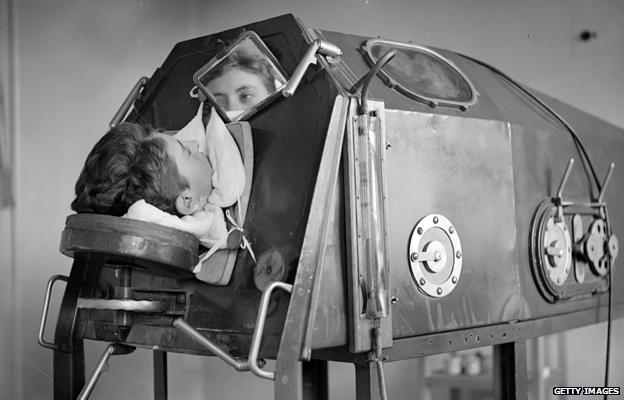
In 1928, Philip Drinker and Louie Shaw developed the "iron lung" to save the lives of those left paralysed by polio and unable to breathe. Most patients would spend around two weeks in the device, but those left permanently paralysed faced a lifetime of confinement. By 1939, around 1,000 were in use in the US. Today, the iron lung is all but gone, made redundant by vaccinations and modern mechanical ventilators.
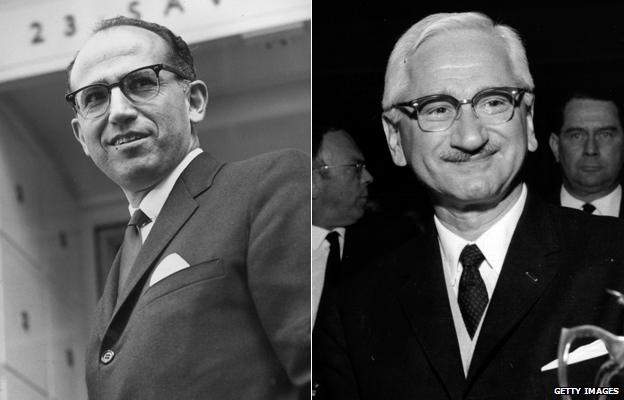
A major breakthrough came in 1952 when Dr Jonas Salk (L) began to develop the first effective vaccine against polio. Mass public vaccination programmes followed and had an immediate effect; in the US alone cases fell from 35,000 in 1953 to 5,300 in 1957. In 1961, Albert Sabin (R) pioneered the more easily administered oral polio vaccine (OPV).
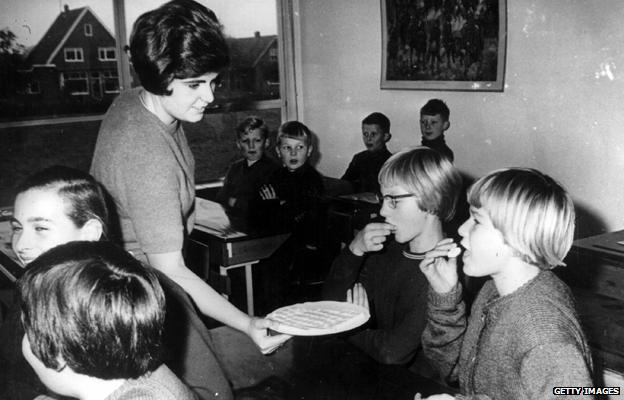
Despite the availability of vaccines polio remained a threat, with 707 acute cases and 79 deaths in the UK as late as 1961. In 1962, Britain switched to Sabin's OPV vaccine, in line with most countries in the developed world. There have been no domestically acquired cases of the disease in the UK since 1982.
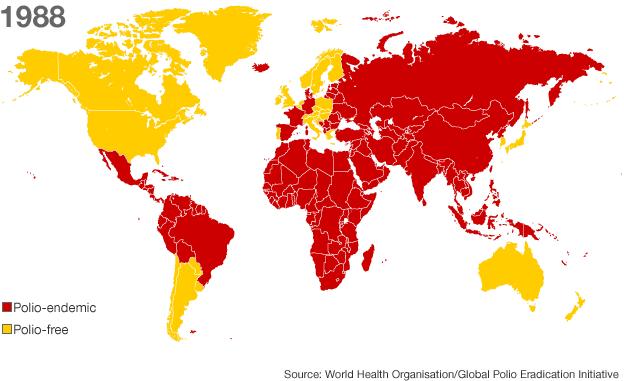
By 1988, polio had disappeared from the US, UK, Australia and much of Europe but remained prevalent in more than 125 countries. The same year, the World Health Assembly adopted a resolution to eradicate the disease completely by the year 2000.

The WHO Americas region was certified polio free in 1994, with the last wild case recorded in the Western Pacific region (which includes China) in 1997. A further landmark came in 2002, when the WHO certified the European region polio-free.

In 2012, Polio remains officially endemic in four countries - Afghanistan, Nigeria, Pakistan and India, which is on the verge of being removed from the list having not had a case since January 2011. Despite so much progress, polio remains a risk with virus from Pakistan re-infecting China in 2011, which had been polio free for more than a decade.
- Published13 January 2014

- Published19 December 2013
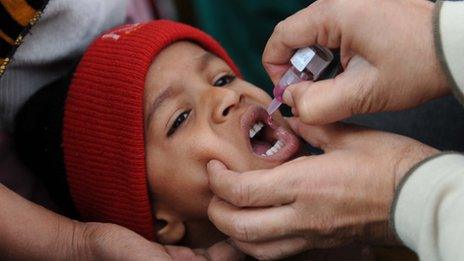
- Published25 September 2015
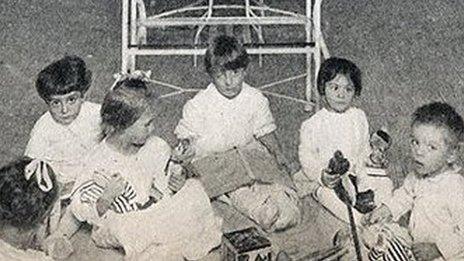
- Published25 January 2012

- Published27 February 2012
- Published10 December 2013

- Published19 December 2012